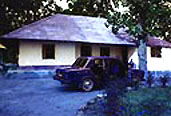
Our forest ("dak") bungalow
at Camp Joranda
Much is being written these days about the great
subcontinent of India, its problems, its politics, and its burgeoning population.
But few are aware that in the midst of all the chaos and confusion there still
exists within the country, realms of such great natural beauty, that appear
almost never to have been tainted by man's encroachment. Such an Eden is Similipal
Tiger Reserve. A day's journey from the teeming metropolis of Calcutta, it lies
hidden, a sanctuary, abundant with wildlife - giving visitors a glimpse of another
India, now passed into history.
Covering an area of 2200 square km nestled within the Similipahar hills, the
Tiger Reserve sits on the south eastern fringes of the Chotanagpur plateau.
Here beneath cerulean skies, a vast stretch of virgin forest endures, blanketed
with a canopy of sal, banyan, peepul and mohua trees. Wild orchids cling to
the branches overhead, cascading to earth in airy tendrils, their blossoms lending
colour to the verdure. Murmuring brooks fed by perennial streams gurgle in the
undergrowth, and wide meandering rivers slip over sharp stone cliffs into deep
transparent pools. This vast territory is home to the tiger, elephant, sambhar
and chital. The Panther, sloth bear and hyena share the forest with lesser creatures
such as porcupine, flying squirrels, and anteaters. Numerous species of snakes,
including the python and the deadly hamadryad make their homes in the red, sulphur-coloured
soil that is pock-marked with their holes. Warbling songbirds fill the air with
the trill of their music. And myriad coloured butterflies flutter amidst the
wild flowers on the grassy slopes of the pale-gold hillocks.
The majestic peaks of Khairiburu and Atharadeuli rise sheer from out of the
impenetrable forest. At the foothills of Atharadeuli lie the crumbling remains
of an ancient temple erected to house the gods of the aboriginal people that
roam these jungles. Here the forest floor is fragrant with the perfume of the
golden champa, whose sweet scented aroma wafts upwards as one carelessly crushes
its yellow petals underfoot. A hush prevails within the dense, impregnable undergrowth,
that is only occasionally disturbed by the belling of the sambhar, or the deep
rough growl of the tiger.
On one of my many visits to India I read about this magical place, and decided
to visit it - to spend some time in quiet isolation within the reserve. However,
the Orrisa government and its officials hold this jewel close their heart. Acquiring
a visitor's permit proved to be a difficult, but not impossible task. Determination
paid off, and Finally, my brother-in-law, sister, and myself, were able to embark
on our journey from Calcutta. It took eight hours to cover the first 275 km
over treacherous laterite roads - we arrived late in the evening at Jashipur,
a small town lying at the foot of the Similipahar hills. Spending the night
at a dak Bungalow, we arose early and purchased our provisions from the local
merchants before continuing our journey into the forest reserve.
 Our forest ("dak") bungalow at Camp Joranda |
Similipal proved to be worth the effort, for this piece of heaven on earth defied description. Each day of our stay unfolded, revealing sights and sounds of such rare beauty, which entirely captured the senses and quieted the soul. We were allotted a forest bungalow called Camp Joranda. Built on a tableland at an elevation of about 150m., it came equipped with Ghandi Ram the cook, Mahanti the guide, and Radha the cat, who sported a earring in her ear. There were no modern amenities in the bungalow, nor were they missed. The fare was simple and satisfying.